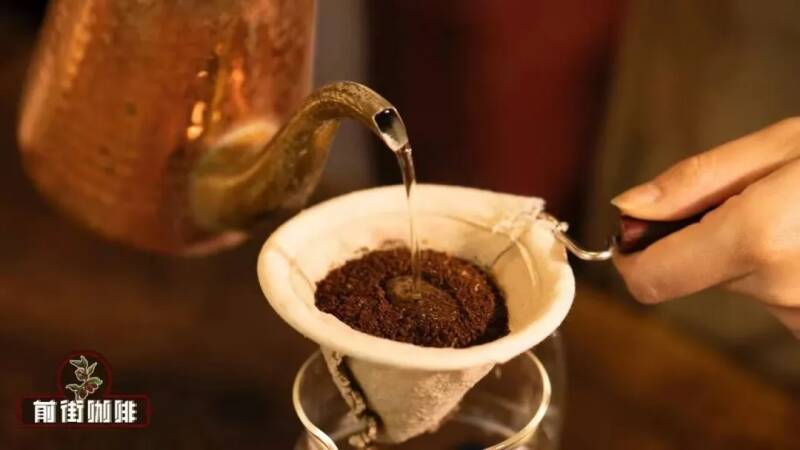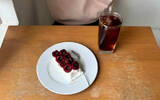Why do Japanese people like to make coffee with flannel? What is the difference between flannel filter cloth and filter paper cup? What are the characteristics of flannel filter cloth for making coffee?
Speaking of flannel filter cloth, many of my friends may have only seen and heard about it in some Japanese film and television dramas or Japanese brewing introduced by bloggers, but have not actually come into contact with it. Because compared to filter cloth, most people use the mainstream filter paper and filter cup when making coffee, the way to know flannel filter cloth is more in the coffee culture related to Japan.

This inevitably made many friends curious, why do Japanese people like to use flannel filter cloth to brew coffee so much? What is the difference between this small filter cloth and the filter paper?
What are the characteristics of flannel filter cloth? or that sentence

If you are a friend who often read tweets on the street, you should already know that the characteristic of brewing with flannel filter cloth is that "it can brew coffee with a stronger aroma." The reason is that flannel filter cloth does not filter as thoroughly as filter paper.
Flannel is a soft suede fabric born in Wales, England. Since its invention, it has been used in various fields due to its extremely wide applicability. The earliest use as a coffee filtering tool can be traced back to the 17th century. Since filter paper had not yet been born at that time, European countries used flannel filter cloth to filter the brewed coffee. But as Qian Jie said, at that time, the function of flannel filter cloth was only to filter the coffee that had been brewed. It was only after hand-brewed coffee was spread to Japan that flannel filter cloth began to be widely used as a filtering/brewing tool for hand-brewed coffee.
Compared with filter paper, the fiber gaps of flannel filter cloth are larger, which allows lipids and some insoluble matters in coffee to pass through. The lipids of coffee contain a certain oil-soluble aroma, so their presence can bring a richer aroma to coffee. Not only that, lipids and insoluble substances can also enhance the taste of coffee and make it more mellow. This is the main reason why flannel filter cloth is popular.
Flannel filter cloth is divided into a suede surface and a cotton surface. The cotton surface will feel rough brought by the weaving pattern, and the suede surface will feel soft brought by fine fleece. (Cotton flour)
Both sides can be used as inner bags to hold coffee powder, but compared to suede, everyone prefers to use cotton flour as inner bags. Because if the suede is stained with coffee powder, it will make cleaning a lot more difficult. Therefore, many friends, including Qianjie, when making coffee with flannel, they are in the same state as velvet outside and cotton inside. (suede)
Then, because flannel filter cloth is usually fixed to a special handle made of metal, we can choose to brew it in our hands, or choose an easier way-hang the flannel filter cloth on the sharing pot like a filter cup. Brew on it. Generally speaking, friends who use flannel filter cloth to brew will choose the latter because it has enough sense of ceremony and makes it more flexible to operate.
Okay, without saying much, let's let Qianjie share how to use flannel filter cloth to brew a delicious pot of coffee!
How to make a cup of coffee with flannel? In fact, the parameters and methods of making coffee with flannel and using filter cups and filter paper are not much different, but if you choose to brew with your hands, then you need to adjust the ratio of powder and water to the ratio of powder and liquid. Because the filter cloth is not in contact with the sharing pot, the electronic scale can only measure the weight of the coffee liquid seeping out of the filter cloth. Since flannel filter cloth is used, Qianjie will naturally choose a deep-roasted coffee bean to brew. Because the characteristics brought by flannel are all needed for deep-roasted coffee, the coffee beans brewed on Qianjie this time are Qianjie Sumatra·PWN Gold Mantonin, which is the medium and deep-roasted bean list. The extraction parameters are as follows: Amount of powder used: 20g powder to liquid ratio: 1:13 (Converted to powder and water ratio is 1:15) Brewing water temperature: 88°C Grinding degree: 10.5 scale of Ek43, 70%~75% sieving rate of No. 20 sieve (it will be thinner than hand brewed) Water injection method: Three-stage Because it is measured based on the powder to liquid ratio, we cannot see the amount of water injected, so when steaming, we no longer inject twice the amount of water into the powder, but moisten the coffee powder. But there are also tricks to wet. First, concentrate hot water in the center and inject it for a period of time, and then slowly wrap it outward until all the coffee powder on the surface is moist. The purpose of this move is to prevent channel effects that cause uneven steaming, and then the time is also 30 seconds.
In 30 seconds, we can start extracting coffee wantonly! Use moderate water flow to slowly inject it in circles from the center to the outside. After reaching the outer ring, it will circle inward. Then repeat the water inside and out until the water level is about to exceed the powder bed. We can stop injecting water. After waiting for the water in the filter to almost penetrate, we will start injecting the next section of hot water at this time.
Starting from the third stage of water injection, our extraction focus should be concentrated in the middle of the powder bed. Therefore, the winding range when we inject water can be appropriately reduced, and we can continue to inject around a coin. Then inject until the target liquid weight is reached, the filter cloth can be removed, and the water injection can be stopped. The total time is 2 minutes and 21 seconds. (Qianjie used 20g of powder, and the powder-to-liquid ratio was 1:13, so the target liquid weight was 260ml)
Qianjie used filter paper and Kono filter cup to brew a pot of gold Mantelin with the same parameters for comparison! After comparison and tasting, Qianjie found that the gold mantinin washed out with flannel was indeed more fragrant than the filter paper and filter cup combination. It will smell more prominent, have a smoother taste when drinking, and have a longer ending after swallowing (it is all a little more, but you can't drink it without comparison).
The flavors of coffee are the same (after all, it's the same bean), and the chocolate, nut, pine, and spice flavors of golden mantinin are all well displayed. However, in terms of cleanliness, the gold mantinin washed out with filter cloth will not be as high as that washed out with filter paper. To sum up, we can know that the coffee washed out of flannel filter cloth and filter paper has different characteristics, and there is no good or bad. Maybe some friends will ask when they see this place, since they have different characteristics, why are there so few coffee shops in China that use flannel products and hand-brewed? Very simple, because hand-punched flannel filter cloth is not a disposable product! In order to be able to be continuously put into use (with a useful life), we need to carry out a series of disinfection and cleaning measures on the filter cloth after use. Compared with the disposable characteristics of filter paper, the use of filter cloth is obviously much more cumbersome.
Therefore, not only in China, but also many people, including Japanese coffee lovers, have chosen a simple and convenient filter paper and cup combination to brew coffee. But Qianjie still said that flannel filter cloth and filter paper each have their own advantages, and there is no difference between good and bad. We can choose and use them according to our own preferences ~
- END -
Important Notice :
前街咖啡 FrontStreet Coffee has moved to new addredd:
FrontStreet Coffee Address: 315,Donghua East Road,GuangZhou
Tel:020 38364473
- Prev

A coffee shop drives customers out on the spot?! Store: No Chinese people are accepted
▲ Click to pay attention| Daily Boutique Coffee Culture Magazine Coffee Factory Recently, Sanxiang Metropolis Daily reported that on October 22, a China netizen who has lived in South Korea for a long time posted on social media saying that a coffee shop in Seoul, South Korea publicly stated that "we do not accept China people." According to netizens, this house is located in Seoul St.
- Next

Can you make coffee with 5g of beans? What is the minimum number of grams of coffee beans used for hand-brewed coffee? What brewing plan should I use for less flour?
It may be used to make special coffee, or it may just want to taste the flavor of coffee nara ~ Occasionally, a friend will have the idea of "making a small cup of coffee with only a few coffee beans." But if you have done it in practice, Qianjie believes it will not be difficult for you to find out: compared to boiling with a large amount of flour, use a small amount of flour to make a cup.
Related
- What is the standard process for the purpose of coffee cup testing? What is the difference between hand-brewed coffee and cup testing?
- How to use hand-brewed coffee paragon small golden balls? How does cold coffee lock in the aroma of coffee?
- Is American coffee black? What is the difference between American coffee and drip coffee?
- Unexpected! Well-known tea beverage brand Lele Tea will withdraw from the Zhengzhou market!
- Starbucks enters the fashion and beauty industry?! Netizen: Give me an ice American eye cream
- Why can American refills for free? The difference between Americano and American drip pot coffee
- Being chased out of the rain in front of Starbucks?! Store: Sheltering from rain under umbrellas poses a safety hazard
- The white moonlight has changed?! Lucky launches "Big Winter Pear American"
- Hand-brewed coffee three-stage method, high-sweet and universal brewing method to share! What does the high sweet water level of hand-brewed coffee mean?
- What is the difference between raw, refined and full espresso coffee? How to extract espresso and taste good?

